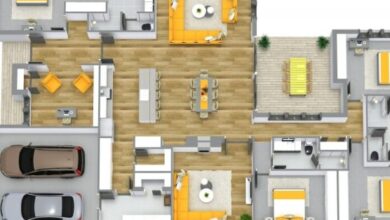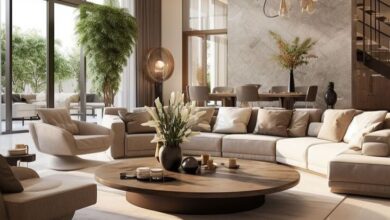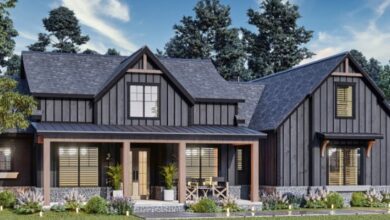Home Decor Trends 2025: The Future of Stylish & Sustainable Living
Home Decor Trends 2025: The Future of Stylish & Sustainable Living – In the fast-paced world of interior design, staying ahead of the trends is essential for creating spaces that are not only visually appealing but also functional and eco-friendly. As we approach 2025, the home decor landscape is evolving to embrace innovative designs, sustainable materials, and smart technology—all while keeping comfort and individuality at the forefront. This article explores the top home decor trends for 2025, providing insight into the future of stylish and sustainable living, and offers actionable tips for incorporating these ideas into your own home.
A New Era in Home Decor
The year 2025 marks a transformative period in the world of interior design. No longer are homes just places to live; they have become sanctuaries that reflect our values, lifestyles, and the pressing need for sustainability. The shift toward eco-conscious choices, combined with the integration of modern technology and a renewed appreciation for craftsmanship, is reshaping how we approach home decor.
The Impact of Global Changes on Interior Design
Global trends are influencing interior design more than ever. Climate change, technological advancements, and evolving work-from-home dynamics have all contributed to a renewed focus on creating spaces that are both adaptive and resilient. Homeowners are seeking designs that not only look good but also contribute positively to the environment and their overall wellbeing. This multifaceted approach to design has given rise to several key trends that we’ll explore in depth.
Embracing Sustainable Materials
One of the most significant shifts in home decor for 2025 is the movement toward sustainability. Homeowners and designers alike are prioritizing eco-friendly materials that minimize environmental impact while offering durability and beauty.
Eco-Friendly Materials and Finishes
From reclaimed wood and bamboo to recycled metal and glass, sustainable materials are taking center stage. These materials not only reduce waste but also bring a natural warmth and texture to interiors. For instance:
- Reclaimed Wood: This material adds a rustic charm and history to your home while reducing the demand for new lumber.
- Bamboo: Known for its rapid renewability, bamboo offers a sleek and modern alternative for flooring, furniture, and decor accents.
- Recycled Metals and Glass: Incorporating these elements can add an industrial edge while maintaining an eco-friendly profile.
Energy-Efficient Lighting and Appliances
Sustainability goes beyond materials. Energy-efficient lighting solutions such as LED fixtures, solar-powered lamps, and smart home systems are becoming ubiquitous. These innovations reduce energy consumption and lower utility bills, aligning with a greener lifestyle without compromising on style.
The Role of Upcycling and DIY
Another exciting trend in sustainable home decor is upcycling. Homeowners are finding creative ways to repurpose old furniture, fabrics, and accessories into unique statement pieces. DIY projects not only add a personal touch but also encourage a more sustainable approach to decorating by extending the life of existing items.
Integrating Smart Technology
The rise of smart technology is revolutionizing how we interact with our living spaces. In 2025, the integration of technology in home decor is more seamless than ever, with smart homes that are not only efficient but also aesthetically pleasing.
Smart Home Automation
From voice-controlled lighting to intelligent climate control systems, smart technology is reshaping our daily lives. Key innovations include:
- Automated Lighting: Adjusting brightness and color temperatures based on the time of day or mood enhances both functionality and ambiance.
- Intelligent Climate Control: Smart thermostats learn your schedule and preferences, ensuring optimal comfort while reducing energy consumption.
- Integrated Security Systems: Modern security solutions are discreet and aesthetically designed, offering peace of mind without detracting from your home’s decor.
The Intersection of Function and Design
The challenge for designers is to integrate these smart solutions in a way that complements the overall design. Sleek, minimalist interfaces and hidden wiring ensure that technology enhances rather than detracts from the beauty of your space. As a result, smart home technology is not just a utility—it’s an integral part of modern interior aesthetics.
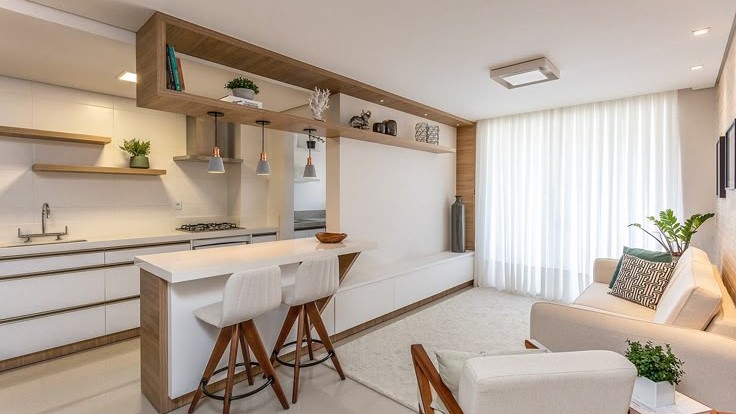
Minimalism and Multifunctional Spaces
While some trends push the envelope with bold colors and eclectic designs, minimalism continues to hold strong in 2025. However, modern minimalism is evolving to incorporate multifunctional spaces that cater to our increasingly dynamic lifestyles.
The Rise of Minimalist Design
Minimalism is about more than just a lack of clutter—it’s a design philosophy that values simplicity, quality, and purposeful design. In a minimalist home, every piece of furniture and decor serves a functional purpose while contributing to a serene environment. The benefits include:
- Enhanced Focus: A clutter-free space encourages relaxation and concentration, which is particularly valuable in a work-from-home setting.
- Versatility: Minimalist spaces are easy to update, allowing homeowners to switch up accents or color schemes without a complete overhaul.
- Timeless Appeal: With clean lines and neutral palettes, minimalist designs are less likely to feel dated, offering long-term appeal.
Designing for Multifunctionality
Modern living demands spaces that adapt to various needs. Multifunctional design is about creating areas that can serve multiple purposes without sacrificing style. Examples include:
- Convertible Furniture: Items like sofa beds, extendable dining tables, and modular storage solutions maximize space in smaller homes.
- Home Offices That Blend In: With more people working from home, integrated home office solutions are designed to seamlessly blend into living spaces. Think of desks that fold away or rooms that double as guest bedrooms.
- Flexible Layouts: Open floor plans and movable partitions allow for dynamic reconfigurations, catering to social gatherings, quiet relaxation, or focused work.
Bold Colors and Unique Patterns
While minimalism thrives on simplicity, 2025 also sees a resurgence of bold colors and unique patterns. These elements inject personality and energy into home decor, offering a refreshing contrast to the clean lines of minimalist design.
The Return of Vibrant Hues
Color trends for 2025 embrace both nature-inspired shades and vivid accents. Designers are experimenting with hues that evoke a sense of optimism and energy:
- Earth Tones: Greens, browns, and ochres bring the outdoors in, creating a calming and organic atmosphere.
- Jewel Tones: Deep blues, emerald greens, and rich purples add a touch of luxury and drama to living spaces.
- Pop Colors: Bold splashes of color in accent walls, furniture, or decor items can transform a neutral space into a vibrant sanctuary.
Incorporating Patterns and Textures
Patterns and textures are also making a strong comeback. Mixing different textures—from plush fabrics and smooth ceramics to rugged natural fibers—creates layers of visual interest. Consider these ideas:
- Geometric Patterns: These add a modern, graphic touch that complements both minimalist and eclectic designs.
- Floral and Botanical Prints: These motifs bring a natural element to interiors and are perfect for creating a warm, inviting atmosphere.
- Textured Walls: Techniques such as Venetian plaster or textured wallpapers provide depth and tactile interest, making a statement without overwhelming the space.
Vintage Meets Modern: A Fusion of Eras
One of the most exciting trends in 2025 is the blending of vintage and modern design elements. This fusion creates a rich narrative within a space, celebrating history while embracing the future.
The Allure of Vintage Pieces
Vintage furniture and decor carry a story and character that modern pieces often lack. These items are cherished for their craftsmanship and uniqueness, making them a valuable addition to any home. In 2025, the trend is to mix vintage finds with contemporary design, creating a balanced, layered look.
Modern Interpretations of Classic Design
Designers are reimagining classic styles with a modern twist. This might include updated color palettes, streamlined silhouettes, or innovative materials that retain the charm of the past while providing modern functionality. Combining the old with the new allows for creative expression and personal storytelling through design.
How to Achieve the Perfect Blend
- Statement Pieces: Choose one or two standout vintage pieces—such as an antique armchair or a retro light fixture—and build the rest of the room around them.
- Mixing Textures: Blend modern materials like glass and metal with traditional wood finishes to create a dynamic, cohesive look.
- Color Coordination: Ensure that the color schemes of vintage and modern items harmonize well. Neutral backdrops can help vintage items pop without clashing with contemporary elements.
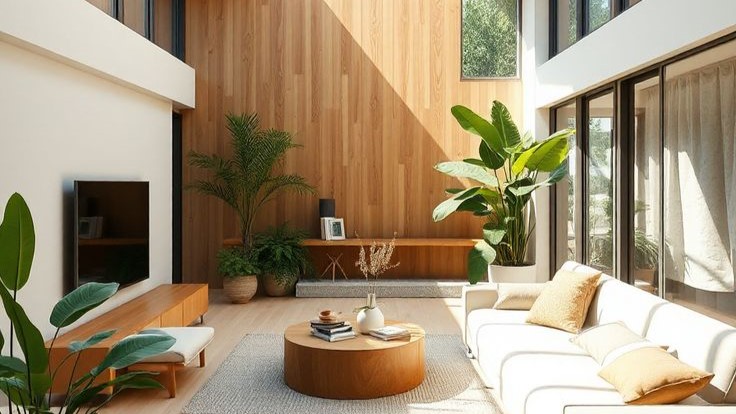
Biophilic Design: Bringing Nature Indoors
The growing awareness of the benefits of nature on mental and physical health has given rise to biophilic design—a trend that emphasizes the connection between humans and nature. In 2025, incorporating natural elements into home decor is not just about aesthetics; it’s about fostering wellbeing.
The Principles of Biophilic Design
Biophilic design is rooted in the idea that incorporating elements of nature into living spaces can reduce stress, boost creativity, and enhance overall wellbeing. Key principles include:
- Natural Light: Maximizing natural light through large windows, skylights, and open layouts not only conserves energy but also improves mood and productivity.
- Greenery: Indoor plants, vertical gardens, and green walls bring life to any space. They not only purify the air but also add vibrant color and texture.
- Natural Materials: Using wood, stone, and other natural materials creates a tactile connection to the outdoors, making spaces feel more organic and inviting.
- Water Elements: Integrating water features such as fountains or aquariums can evoke a sense of calm and tranquility.
Practical Tips for Biophilic Interiors
- Plant Corners: Dedicate a corner of your living room or kitchen to a variety of indoor plants. Consider low-maintenance options like succulents or ferns.
- Natural Decor: Use accessories made from natural fibers, such as wool throws, linen cushions, or jute rugs, to enhance the tactile experience.
- Outdoor Views: Arrange furniture to take full advantage of any outdoor views, creating a seamless connection between your interior space and nature.
Customization and Personalization
As homeowners become more discerning about their living environments, customization and personalization are emerging as key trends for 2025. Rather than following a one-size-fits-all approach, modern interiors are evolving to reflect the personality and lifestyle of those who inhabit them.
Tailored Spaces for Every Lifestyle
The trend toward personalization is evident in every aspect of home decor—from bespoke furniture to custom artwork. Designers are increasingly offering tailored solutions that cater to the unique needs of each client. Whether it’s a custom-built bookshelf that doubles as a work area or personalized lighting setups that adjust to your mood, the emphasis is on creating spaces that feel truly yours.
The Role of Technology in Customization
Advancements in technology are making it easier than ever to create personalized spaces. Virtual reality (VR) and augmented reality (AR) tools allow homeowners to visualize changes before they are implemented, ensuring that every detail meets their exact specifications. Moreover, online platforms and apps provide endless inspiration and allow for easy customization of everything from paint colors to furniture arrangements.
DIY and Artisan Movements
Customization isn’t just about high-tech solutions. There is also a growing interest in DIY projects and artisan craftsmanship. Local artisans and small businesses are being celebrated for their ability to produce one-of-a-kind pieces that add character and individuality to homes. Embracing these handcrafted items not only supports local economies but also enriches your decor with stories and heritage.
The Future of Home Decor Trends
As we look ahead to the remainder of 2025 and beyond, several trends are set to shape the future of home decor. These trends reflect a broader cultural shift toward mindfulness, sustainability, and intentional living.
A More Conscious Consumer
Modern homeowners are more informed and conscious about the environmental and social impacts of their purchasing decisions. This shift is encouraging designers and manufacturers to adopt sustainable practices and ethical sourcing. The focus on quality over quantity means that future trends will likely emphasize timeless design and durability rather than fleeting fads.
Adaptive and Resilient Design
The uncertainty of global events has also influenced the way we design our homes. Flexibility and adaptability are key. Future home decor trends will prioritize resilient design elements that can accommodate changes in lifestyle, whether that means transforming a living room into a home office or creating multifunctional spaces that can host both family gatherings and intimate solo retreats.
Merging Digital and Physical Realms
The integration of digital technology into physical spaces is only set to deepen. As smart home technologies become more intuitive and integrated, the distinction between digital and physical living spaces will blur. This convergence promises not only to enhance convenience and efficiency but also to create more engaging and interactive environments that evolve with the needs of the homeowner.
The Continued Influence of Global Cultures
Globalization continues to bring diverse influences to the forefront of design. In 2025, expect to see an even greater blending of cultural motifs, with traditional crafts, patterns, and materials from around the world being incorporated into modern interiors. This eclectic mix not only celebrates cultural diversity but also enriches our living spaces with a deeper sense of history and identity.
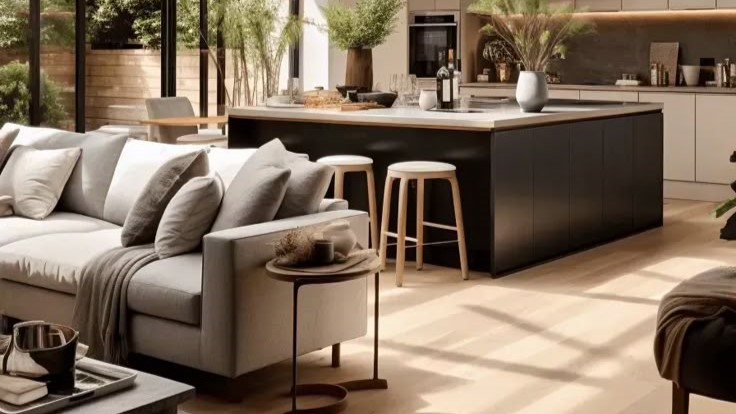
Actionable Tips for Embracing 2025 Home Decor Trends
Whether you’re planning a full home renovation or simply looking to refresh a single room, here are some practical tips to incorporate the 2025 home decor trends into your living space:
1. Start with a Sustainable Mindset
- Audit Your Space: Take a look at what you already own. Identify pieces that can be repurposed or updated rather than discarded.
- Research Materials: When shopping for new items, prioritize eco-friendly materials like reclaimed wood, bamboo, or recycled metal.
- Invest in Quality: Choose pieces that are built to last, even if they come with a higher price tag. Longevity is a key aspect of sustainability.
2. Integrate Smart Technology Seamlessly
- Plan Your Layout: Consider how technology can be integrated without overwhelming your space. Hidden wiring and discreet devices can maintain a clean aesthetic.
- Choose Multi-Functional Gadgets: Invest in technology that offers both form and function, such as smart lighting systems that enhance mood and energy efficiency.
- Embrace Automation: Let smart home systems manage your energy consumption. This not only reduces your carbon footprint but also simplifies your daily routines.
3. Balance Minimalism with Personal Expression
- Declutter Thoughtfully: A minimalist approach doesn’t mean stripping your home of personality. Instead, focus on curating items that truly matter to you.
- Mix and Match: Blend minimalistic designs with bold accent pieces. A single vibrant piece of art or a statement furniture item can elevate an otherwise understated room.
- Adapt Spaces: Create multifunctional areas that cater to your lifestyle needs. Whether it’s a home office that transitions into a guest room or a living area that serves as a yoga studio, flexibility is key.
4. Bring the Outdoors In
- Invest in Indoor Plants: Start with easy-to-care-for plants that can thrive indoors. They not only purify the air but also add a splash of natural color.
- Utilize Natural Materials: Incorporate natural textures through decor items like jute rugs, linen curtains, or stone accents.
- Maximize Natural Light: Arrange furniture to take full advantage of windows and skylights. Natural light is essential for a vibrant, inviting atmosphere.
5. Embrace Customization and Personal Touches
- DIY Projects: Get creative with DIY projects. Whether it’s repainting an old piece of furniture or creating your own artwork, personalization adds unique charm.
- Support Local Artisans: Seek out locally made or handcrafted items. These pieces often carry a story and can become conversation starters in your home.
- Use Technology for Design: Experiment with virtual design tools to preview how different elements will look together before making a commitment.
Conclusion: A Vision for 2025
Home decor in 2025 is set to be a dynamic blend of style, sustainability, and smart technology. The trends outlined in this article illustrate a shift toward mindful living—one that values quality, embraces technological innovation, and cherishes the beauty of the natural world. As homeowners become more discerning about the impact of their choices, the future of interior design looks not only stylish and functional but also deeply rooted in sustainability.
Whether you’re redesigning an entire home or simply looking to refresh a single room, the insights provided here offer a roadmap for creating spaces that are truly ahead of their time. By embracing eco-friendly materials, integrating smart technology, balancing minimalism with bold accents, and incorporating natural elements, you can craft a home that reflects your personality, meets modern demands, and contributes positively to the environment.
The journey to a more sustainable and stylish home starts with informed choices and a willingness to innovate. As we move further into 2025, let these trends inspire you to rethink traditional design and explore new possibilities. The future of home decor is bright—and it’s yours to create.
Key Takeaways for a Future-Ready Home
- Sustainability is Paramount: Emphasize eco-friendly materials, energy-efficient solutions, and sustainable practices in every design decision.
- Smart Technology Enhances Living: Integrate advanced technologies in a way that complements your home’s aesthetic while boosting functionality.
- Minimalism Meets Flexibility: Focus on clean, clutter-free spaces that can adapt to various lifestyle needs without sacrificing personal style.
- Nature as a Design Element: Incorporate biophilic design principles to bring the calming influence of nature indoors.
- Personalization and Local Touch: Combine modern trends with vintage or handcrafted elements to create spaces that tell your story.
By staying informed about these evolving trends and integrating them into your home, you are not just following a design trend—you are investing in a lifestyle that is both forward-thinking and rooted in a respect for the planet. In the end, a home is more than just a physical space; it’s a living, evolving reflection of who we are and the future we want to build.

